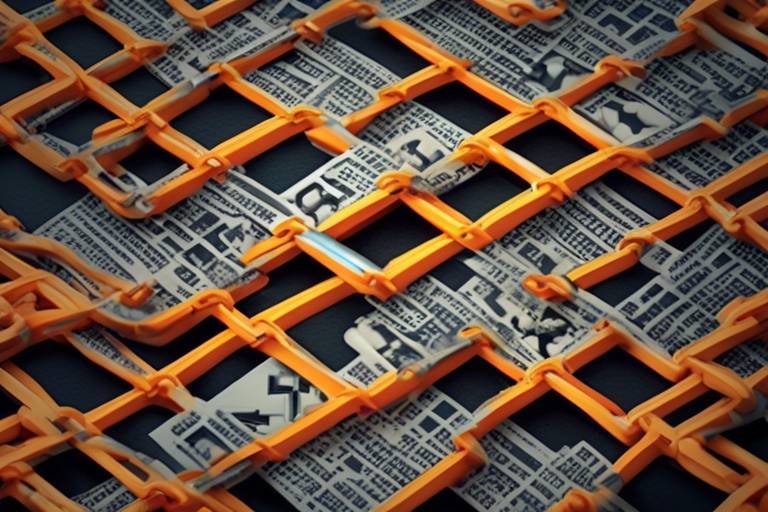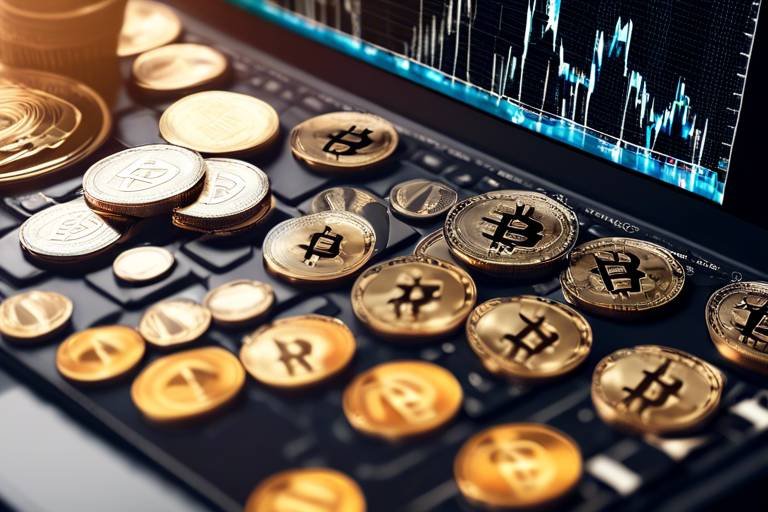How to Use Blockchain for Provenance Tracking
In a world where consumers are increasingly concerned about where their products come from, the need for transparency in supply chains has never been more critical. Blockchain technology is stepping up to the plate, offering innovative solutions for tracking the provenance of products. Imagine being able to trace every step of a product's journey, from its origin to the store shelf, with absolute certainty. This isn't just a dream; it's a reality made possible by blockchain. By utilizing a decentralized ledger, businesses can ensure that every transaction is recorded securely and transparently, allowing them to provide verifiable information to consumers.
So, what exactly does this mean for industries ranging from food to luxury goods? Well, for starters, it means that consumers can trust the authenticity of the products they purchase. No more worrying about whether that organic label is genuine or if the diamond ring is indeed conflict-free. Blockchain serves as a digital fingerprint for products, creating a permanent record that can be accessed by anyone in the supply chain. This level of transparency not only enhances consumer trust but also builds a stronger brand reputation.
Furthermore, the application of blockchain in provenance tracking goes beyond mere consumer confidence. It plays a crucial role in ethical sourcing and compliance with regulations. In industries like food and pharmaceuticals, where safety is paramount, being able to track a product's journey can mean the difference between life and death. Imagine a food recall scenario where a contaminated product can be traced back to its source almost instantly, minimizing health risks. This capability is invaluable and highlights why businesses should consider implementing blockchain technology.
However, adopting blockchain for provenance tracking is not without its challenges. Companies may face technical hurdles, financial constraints, and even organizational resistance when trying to integrate this technology into their existing systems. It's essential for businesses to weigh these challenges against the potential benefits, as the long-term gains in consumer trust and operational efficiency can far outweigh the initial investment.
As we delve deeper into the applications of blockchain for provenance tracking, we'll explore real-world case studies that illustrate its effectiveness. From the food industry ensuring the safety of products to the luxury goods sector combating counterfeiting, the possibilities are endless. The future of blockchain in provenance tracking looks promising, with emerging trends like interoperability and the integration of IoT devices set to further enhance its capabilities.
- What is provenance tracking? Provenance tracking is the process of tracing the history of a product from its origin to its final destination, ensuring transparency and authenticity.
- How does blockchain enhance provenance tracking? Blockchain provides a secure, decentralized ledger that records every transaction, making it easy to verify the authenticity and journey of a product.
- What are the challenges of implementing blockchain? Challenges include technical integration, financial costs, and potential resistance from within the organization.
- Can blockchain be used in all industries? While blockchain is applicable in many sectors, its effectiveness and implementation may vary based on industry-specific needs.
Understanding Blockchain Technology
Blockchain technology is often described as a revolutionary force, akin to the internet's impact on communication. At its core, blockchain is a decentralized ledger that records transactions across multiple computers. This decentralization ensures that no single entity has control over the entire chain, making it inherently secure and transparent. Imagine a digital notebook that everyone can see but no one can erase; that's blockchain in a nutshell.
The beauty of blockchain lies in its core principles. Each transaction or piece of data is grouped into a block, which is then linked to the previous block, forming a chain. This linkage is secured by cryptographic hashes, which act like digital fingerprints for each block, ensuring that any tampering is easily detectable. Once a block is added to the chain, it becomes nearly impossible to alter without the consensus of the network. This feature is what gives blockchain its reputation for security and integrity.
How does blockchain function in practice? Picture a group of friends sharing a list of their favorite movies. Instead of one person keeping the list, everyone has their own copy. When someone adds a new movie, all copies are updated simultaneously. This is similar to how blockchain operates: when a transaction occurs, it is broadcast to the network, where it is verified by multiple nodes (computers). Once verified, the transaction is added to the blockchain, and all nodes update their copies of the ledger.
Furthermore, blockchain can operate in various forms, including public, private, and consortium blockchains. Each type serves different purposes and offers varying levels of access and control. For instance, public blockchains like Bitcoin allow anyone to participate, while private blockchains restrict access to a select group, making them ideal for businesses that require privacy and control over their data.
In summary, understanding blockchain technology is essential for grasping its potential impact on various industries, especially in provenance tracking. Its decentralized nature, coupled with its security features, makes it a powerful tool for ensuring transparency and trust in supply chains. As we delve deeper into the significance of provenance tracking, it's clear that blockchain is not just a buzzword; it's a game-changer.
The Importance of Provenance Tracking
In today's globalized world, where products traverse multiple borders before reaching the consumer, provenance tracking has emerged as an essential component of supply chain management. But why is this tracking so crucial? Simply put, it provides a transparent view of a product's journey from its origin to the end user, ensuring that consumers can trust what they purchase. Imagine buying a bottle of wine; wouldn’t you want to know if it was produced ethically, or if it contains additives that you might want to avoid? Provenance tracking answers these questions and more.
One of the primary reasons provenance tracking is vital is its role in ensuring product authenticity. In an age where counterfeit goods flood the market, consumers are increasingly concerned about whether what they're buying is genuine. Provenance tracking allows businesses to provide verifiable information about the origins of their products. For example, a luxury handbag brand can use blockchain to demonstrate that their products are made from sustainably sourced materials, directly from the original suppliers. This not only reassures customers but also strengthens brand loyalty.
Moreover, provenance tracking plays a significant role in ethical sourcing. Consumers today are more conscious than ever about the impact of their purchases. They want to know if the products they buy are sourced responsibly and produced under fair labor conditions. By utilizing technologies like blockchain, companies can transparently share their supply chain practices, showcasing their commitment to ethical standards. This transparency can significantly enhance a brand's reputation and attract a more socially conscious consumer base.
Additionally, provenance tracking is essential for regulatory compliance. In industries such as food and pharmaceuticals, regulations require strict adherence to safety and quality standards. Provenance tracking ensures that every step of the supply chain is documented and traceable, making it easier for companies to comply with regulations and avoid costly fines. For instance, if a food safety issue arises, companies can quickly trace the source of contamination back through the supply chain, minimizing risk and protecting consumers.
To illustrate the importance of provenance tracking, consider this: when a product's origin is transparent, consumer trust increases. A survey conducted by the Consumer Goods Forum showed that 75% of consumers are more likely to purchase from brands that provide detailed information about their products' origins. This statistic highlights a crucial point—consumers are willing to support brands that prioritize transparency and ethical practices. In turn, businesses that embrace provenance tracking can see a direct impact on their sales and market reputation.
In conclusion, the importance of provenance tracking cannot be overstated. It not only ensures product authenticity and ethical sourcing but also aids in regulatory compliance and fosters consumer trust. As we move into an era where transparency is increasingly demanded by consumers, businesses that adopt provenance tracking will undoubtedly have a competitive edge in the market.
- What is provenance tracking? Provenance tracking is the process of documenting and verifying the history of a product as it moves through the supply chain, from its origin to the final consumer.
- Why is provenance tracking important? It ensures product authenticity, promotes ethical sourcing, aids in regulatory compliance, and enhances consumer trust.
- How does blockchain facilitate provenance tracking? Blockchain provides a decentralized and secure method for recording transactions, making it easier to trace the origins and journey of products.
- What industries benefit from provenance tracking? Industries such as food, pharmaceuticals, luxury goods, and fashion significantly benefit from implementing provenance tracking.
Benefits of Provenance Tracking
In today's fast-paced market, where consumers are more informed than ever, provenance tracking has emerged as a game-changer for businesses across various sectors. The ability to trace a product's journey from its origin to the end consumer not only enhances transparency but also builds a solid foundation of trust between brands and their customers. Imagine purchasing a bottle of olive oil and knowing exactly which farm it came from, how it was harvested, and the ethical practices involved in its production. This level of insight is not just a luxury; it's becoming a necessity in modern commerce.
One of the most significant benefits of implementing provenance tracking is the increased consumer trust. When consumers can verify the authenticity of a product, they are more likely to make a purchase. This trust is particularly crucial in industries like food and pharmaceuticals, where safety and quality are paramount. For instance, if a customer can scan a QR code on their favorite chocolate bar and see its entire supply chain, they are more likely to feel confident in their choice, knowing that the product meets their ethical and quality standards.
Moreover, provenance tracking can lead to an improved brand reputation. Companies that are transparent about their sourcing and production processes often enjoy a competitive edge. Consumers appreciate brands that align with their values, such as sustainability and ethical sourcing. This alignment can translate into customer loyalty and repeat business. When customers feel connected to a brand's story, they are more likely to recommend it to others, further enhancing the company's reputation.
Another critical advantage is the enhancement of operational efficiency. By utilizing blockchain technology for provenance tracking, businesses can streamline their supply chain processes. This technology provides real-time data that can help companies identify inefficiencies and areas for improvement. For example, if a batch of products is delayed, companies can quickly trace back through the supply chain to identify the bottleneck. This capability not only saves time and resources but also minimizes the risk of losses due to inefficiencies.
Furthermore, provenance tracking can help businesses comply with regulatory requirements. In many industries, particularly food and pharmaceuticals, there are strict regulations governing product safety and sourcing. Provenance tracking provides a clear audit trail that can be invaluable during compliance checks. With a transparent record of every step in the supply chain, companies can easily demonstrate that they meet all necessary standards, thus avoiding potential legal issues and fines.
In summary, the benefits of provenance tracking are manifold. From fostering consumer trust and enhancing brand reputation to improving operational efficiency and ensuring regulatory compliance, the advantages are clear. As businesses continue to navigate the complexities of today's market, embracing provenance tracking through blockchain technology is not just a trend; it's an essential strategy for long-term success.
- What is provenance tracking? Provenance tracking refers to the process of tracing the origin and journey of a product through its supply chain, ensuring transparency and authenticity.
- How does blockchain technology help in provenance tracking? Blockchain technology provides a secure, decentralized ledger that records every transaction in the supply chain, making it easy to verify product origins and movements.
- Why is consumer trust important in provenance tracking? Consumer trust is crucial because it influences purchasing decisions. When consumers can verify product authenticity, they are more likely to buy and recommend the product.
- What industries benefit the most from provenance tracking? Industries such as food, pharmaceuticals, luxury goods, and fashion significantly benefit from provenance tracking due to the importance of safety, quality, and authenticity.
Consumer Trust and Transparency
In today's fast-paced market, where consumers are more informed and conscious than ever, trust has become a currency of its own. The rise of social media and instant information sharing means that a single misstep can lead to a brand's downfall. This is where provenance tracking through blockchain technology comes into play, acting as a beacon of transparency that can illuminate the often murky waters of supply chains. Imagine being able to trace the journey of your favorite product, from its origin to your doorstep, with just a few clicks. This level of transparency not only reassures consumers but also empowers them to make informed choices.
With blockchain, every transaction is recorded on a decentralized ledger that is immutable and publicly accessible. This means that once information is entered, it cannot be altered or deleted, creating a permanent and trustworthy record. For consumers, this translates into a greater understanding of where their products come from, how they are made, and the ethical practices involved in their production. For instance, when purchasing organic food, consumers can verify its organic certification and trace its journey from farm to table, ensuring that it meets their standards.
Moreover, the impact of consumer trust on brand loyalty cannot be overstated. A study by the Harvard Business Review found that companies that prioritize transparency often see a significant increase in customer loyalty. When consumers feel confident that they are purchasing authentic products, they are more likely to return to the brand. This creates a virtuous cycle where transparency breeds trust, and trust fosters loyalty. As a result, brands that embrace blockchain for provenance tracking not only enhance their reputation but also cultivate a dedicated customer base.
However, it’s important to note that transparency is not just about revealing information; it’s also about how that information is communicated. Brands must present the data in a way that is easily digestible and engaging. For example, integrating QR codes on product packaging that link to detailed provenance information can enhance the consumer experience. This interactive approach allows consumers to explore the story behind their purchases, making them feel more connected to the products they buy.
In conclusion, the intersection of consumer trust and transparency is a powerful one, and blockchain technology serves as a robust tool to foster this relationship. By enabling a clear view of the supply chain, brands can not only build trust but also differentiate themselves in a crowded marketplace. As consumers continue to demand more transparency, those who adapt will not only survive but thrive in the new economy.
- What is blockchain technology? Blockchain is a decentralized digital ledger that records transactions across multiple computers securely and transparently.
- How does provenance tracking work? Provenance tracking uses blockchain to record the journey of a product from its origin to the consumer, ensuring authenticity and transparency.
- Why is consumer trust important? Consumer trust is crucial for brand loyalty and can significantly impact a company's reputation and sales.
- Can blockchain help in regulatory compliance? Yes, blockchain can provide verifiable records that help companies meet regulatory standards, especially in industries like food and pharmaceuticals.
Regulatory Compliance
In today's rapidly evolving marketplace, regulatory compliance is more crucial than ever. Companies across various industries face increasing scrutiny from governments and consumers alike, making it imperative to adhere to strict regulations. Blockchain technology emerges as a powerful ally in this regard, providing a transparent and immutable record of transactions that can significantly ease the burden of compliance. Imagine a digital ledger that not only records every transaction but does so in a way that is accessible and verifiable by all stakeholders. This is the essence of blockchain, and it can transform how businesses approach regulatory standards.
One of the most significant advantages of using blockchain for regulatory compliance is its ability to enhance traceability. For instance, in the food industry, regulations dictate that companies must be able to trace the origin of their products to ensure safety and quality. With blockchain, every step of a product's journey—from farm to fork—is recorded in a secure and transparent manner. This not only helps businesses comply with food safety regulations but also allows them to respond swiftly to any issues that may arise, such as recalls. The transparency provided by blockchain means that consumers can have confidence in the safety of the products they purchase.
Furthermore, in sectors like pharmaceuticals, regulatory bodies such as the FDA require rigorous tracking of drug manufacturing and distribution processes. Blockchain can facilitate this by ensuring that every transaction involving a pharmaceutical product is recorded and can be audited. This level of detail not only helps in meeting regulatory requirements but also protects companies from potential legal issues related to non-compliance. By leveraging blockchain, businesses can create a robust compliance framework that simplifies the audit process and reduces the risk of penalties.
However, while the benefits are substantial, implementing blockchain for compliance is not without challenges. Companies must navigate technical hurdles, including integrating blockchain with existing systems and ensuring data accuracy. Moreover, the financial implications of adopting this technology can be daunting. Yet, the long-term benefits—such as reduced compliance costs and enhanced trust—often outweigh these initial investments.
In conclusion, regulatory compliance is a significant concern for businesses today, and blockchain technology offers a compelling solution. By providing a transparent and immutable record of transactions, blockchain not only helps companies meet regulatory requirements but also builds trust with consumers. As more industries recognize the importance of compliance, the adoption of blockchain for provenance tracking is likely to increase, paving the way for a more transparent and accountable marketplace.
- What is blockchain technology? Blockchain is a decentralized digital ledger that records transactions across many computers in a way that the registered transactions cannot be altered retroactively.
- How does blockchain enhance regulatory compliance? By providing a transparent and immutable record of transactions, blockchain simplifies the audit process and ensures that businesses can easily prove compliance with regulations.
- What industries benefit from blockchain for provenance tracking? Industries such as food, pharmaceuticals, and luxury goods are leading the way in adopting blockchain for tracking product origins and ensuring compliance.
- Are there challenges to implementing blockchain? Yes, challenges include technical integration, financial costs, and ensuring data accuracy, but the benefits often outweigh these hurdles.
Challenges in Implementing Blockchain
Implementing blockchain technology for provenance tracking can feel like trying to navigate a labyrinth without a map. While the benefits are enticing, the road to adoption is often riddled with challenges that can leave businesses feeling overwhelmed. One of the primary hurdles is the technical complexity associated with blockchain systems. Many organizations lack the necessary expertise to develop, deploy, and maintain blockchain solutions. This technical gap can lead to significant delays and increased costs, as companies may need to invest in training or hire specialized talent.
Moreover, there’s the financial burden that comes with implementing blockchain technology. The initial investment required for developing a blockchain infrastructure can be substantial. Companies must consider not only the costs of technology and software but also the expenses related to training staff and integrating existing systems with the new blockchain solution. For small to medium-sized enterprises, these costs can be prohibitive, leading to hesitation in adopting this innovative technology.
Another significant challenge is the organizational resistance to change. Blockchain adoption often requires a fundamental shift in how companies operate, which can be met with skepticism from employees accustomed to traditional processes. Resistance can stem from fear of the unknown or concerns about job security as automation and new technologies come into play. To overcome this, businesses must foster a culture of innovation and provide clear communication about the benefits of blockchain technology, emphasizing how it can enhance their roles rather than replace them.
Additionally, interoperability issues pose a challenge. Different blockchain platforms may not communicate seamlessly with each other, creating silos of information that can hinder the benefits of provenance tracking. Companies need to collaborate not only within their organization but also across the entire supply chain to ensure that all parties can access and share data effectively. This necessitates establishing standards and protocols that can bridge the gaps between various blockchain systems.
Lastly, there’s the question of regulatory compliance. As blockchain technology continues to evolve, so do the laws and regulations surrounding its use. Companies must navigate a complex landscape of legal requirements that can vary by industry and region. Ensuring compliance while implementing blockchain for provenance tracking can be daunting, as businesses need to stay updated on regulatory changes and adapt their practices accordingly.
In summary, while blockchain technology offers remarkable potential for enhancing provenance tracking, businesses must be prepared to face several challenges. Addressing these issues requires a strategic approach, investment in resources, and a commitment to fostering a culture of innovation. By overcoming these hurdles, organizations can unlock the full potential of blockchain and reap the benefits of increased transparency and trust in their supply chains.
- What is blockchain technology? - Blockchain is a decentralized digital ledger that records transactions across many computers, ensuring that the recorded data cannot be altered retroactively.
- How does blockchain enhance provenance tracking? - By providing a transparent and immutable record of a product's journey through the supply chain, blockchain helps verify authenticity and ethical sourcing.
- What industries can benefit from blockchain provenance tracking? - Industries such as food, pharmaceuticals, luxury goods, and agriculture can significantly benefit from enhanced transparency and trust.
- What are the main challenges of implementing blockchain? - Key challenges include technical complexity, financial costs, organizational resistance, interoperability issues, and regulatory compliance.
Case Studies of Successful Implementations
In recent years, several companies have stepped up to the plate, utilizing blockchain technology for provenance tracking with remarkable success. These case studies not only highlight the potential of blockchain but also serve as a beacon of inspiration for other industries looking to enhance their supply chain transparency. Let's dive into a couple of standout examples that illustrate how blockchain has transformed the way businesses operate.
One of the most notable implementations can be found in the food industry. A major player, Walmart, has embraced blockchain to track the journey of its food products. By collaborating with IBM on the Food Trust initiative, Walmart can trace the origin of its produce in mere seconds. This is a game-changer, especially in the wake of food safety scares, where knowing the source of contamination quickly can save lives and prevent widespread panic. The transparency offered by blockchain allows consumers to feel secure about their food choices, knowing they can trace their meals back to the farm.
In addition to food, the luxury goods sector has also seen significant benefits from blockchain technology. A prime example is the partnership between Everledger and diamond retailers. Everledger uses blockchain to create a digital ledger for diamonds, ensuring their authenticity and tracing their journey from mine to market. This initiative not only combats counterfeiting but also addresses ethical concerns surrounding blood diamonds. By providing a transparent record, consumers can make informed purchasing decisions, leading to increased trust and brand loyalty.
Moreover, the fashion industry is beginning to adopt blockchain for similar reasons. Brands like Provenance are leveraging this technology to allow consumers to see the entire lifecycle of their clothing. From the raw materials to the final product, customers can verify the sustainability and ethical practices behind their purchases. This level of transparency not only enhances brand reputation but also aligns with the growing consumer demand for responsible sourcing.
These case studies exemplify how blockchain can revolutionize various industries by providing a secure, transparent, and efficient method for tracking provenance. As more companies recognize the value of this technology, we can expect to see an increasing number of successful implementations across the globe.
- What is blockchain technology? Blockchain is a decentralized digital ledger that records transactions across many computers in such a way that the registered transactions cannot be altered retroactively.
- How does provenance tracking work? Provenance tracking uses blockchain to create an immutable record of a product's journey through the supply chain, ensuring transparency and authenticity.
- What industries benefit from blockchain provenance tracking? Industries such as food, luxury goods, fashion, pharmaceuticals, and more benefit from enhanced transparency and traceability through blockchain.
- Are there challenges to implementing blockchain? Yes, challenges include technical complexities, financial costs, and the need for organizational change to integrate blockchain into existing systems.
Food Industry Applications
The food industry is one of the most exciting areas where blockchain technology is making waves, and for good reason. Imagine biting into a juicy apple and knowing exactly where it came from, how it was grown, and what journey it took to reach your plate. This level of transparency is not just a dream; it's becoming a reality thanks to blockchain. By leveraging this innovative technology, food producers can track the entire journey of their products from farm to table, ensuring safety, quality, and compliance with health standards.
One of the most significant applications of blockchain in the food industry is in enhancing food safety. With blockchain, every transaction and movement of food products can be recorded in a secure, immutable ledger. This means that if a contamination issue arises, companies can quickly trace the source of the problem. For instance, if a batch of spinach is found to be contaminated, blockchain allows for rapid identification of the farms and suppliers involved, thereby minimizing health risks to consumers. This not only protects public health but also helps businesses avoid costly recalls and maintain their reputations.
Moreover, blockchain technology can significantly enhance traceability in the food supply chain. Each participant in the supply chain—from farmers and processors to distributors and retailers—can update the blockchain with relevant data. This creates a comprehensive history of the product, which can be accessed by anyone involved in the supply chain. For consumers, this means they can scan a QR code on their food packaging to see the entire journey of their food, including where it was grown, how it was processed, and when it was delivered to the store. This level of transparency is not only reassuring but also empowers consumers to make informed choices about their food.
In addition to safety and traceability, blockchain can also play a crucial role in promoting sustainable practices in the food industry. For example, by providing verifiable information about farming practices, consumers can support brands that prioritize ethical sourcing and environmentally friendly methods. This is particularly important in today's market, where consumers are becoming increasingly conscious of the impact their purchases have on the planet. By integrating blockchain into their operations, companies can showcase their commitment to sustainability, which can enhance brand loyalty and attract a more environmentally aware customer base.
To illustrate the impact of blockchain in the food industry, consider the following table that outlines some key benefits:
| Benefit | Description |
|---|---|
| Enhanced Traceability | Allows for quick identification of product origins and supply chain history. |
| Improved Food Safety | Facilitates rapid response to contamination issues, protecting public health. |
| Increased Consumer Trust | Provides transparency that empowers consumers to make informed choices. |
| Promotion of Sustainable Practices | Encourages ethical sourcing and environmentally friendly methods. |
As we move forward, the adoption of blockchain in the food industry is expected to grow. Companies that embrace this technology will not only enhance their operational efficiency but also position themselves as leaders in transparency and sustainability. In a world where consumers are increasingly demanding accountability, blockchain offers a powerful solution to meet those expectations while fostering trust and loyalty.
Q: How does blockchain improve food safety?
A: Blockchain improves food safety by allowing for quick traceability of products. In case of contamination, companies can easily identify the source and take necessary actions swiftly.
Q: Can consumers access information about their food through blockchain?
A: Yes! Consumers can scan QR codes on packaging to see the entire journey of their food, including where it was sourced and how it was processed.
Q: What are the sustainability benefits of using blockchain in the food industry?
A: Blockchain promotes sustainable practices by providing verifiable information about ethical sourcing and environmentally friendly farming methods, encouraging consumers to support responsible brands.
Luxury Goods and Authenticity
The luxury goods market has always been a playground for counterfeiters, with fake products flooding the market and undermining the value of genuine items. Imagine purchasing a stunning designer handbag, only to discover it’s a cheap imitation. This scenario is a nightmare for consumers and brands alike. Fortunately, blockchain technology is stepping in to save the day. By leveraging this innovative technology, companies can ensure the authenticity of luxury goods, providing both consumers and brands with peace of mind.
Blockchain acts as a digital ledger that records every transaction related to a product, from the moment it is created to the time it reaches the consumer. This means that each item can be traced back to its origin, offering a transparent view of its journey. For luxury brands, this is a game changer. It allows them to not only prove the authenticity of their products but also to tell a compelling story about their craftsmanship and heritage. Imagine being able to scan a QR code on a luxury item and instantly access its entire history, including where it was made, the materials used, and even the artisans who crafted it. This level of transparency builds trust with consumers, who are increasingly savvy and demand proof of authenticity.
Moreover, the integration of blockchain with other technologies, such as the Internet of Things (IoT), can further enhance this authenticity verification process. For example, smart tags can be embedded in luxury products, allowing them to communicate their status and history directly to consumers. This not only helps in verifying authenticity but also in combating fraud. Brands can easily track their products and identify any discrepancies in the supply chain, enabling them to take swift action against counterfeiters.
However, the implementation of blockchain in the luxury goods sector is not without its challenges. Many brands are still grappling with the costs associated with integrating this technology into their existing systems. Additionally, there’s the question of consumer education; many shoppers may not fully understand how blockchain works or why it matters. To address these concerns, brands need to invest in marketing and educational campaigns that highlight the benefits of blockchain for authenticity.
In conclusion, blockchain technology is revolutionizing the luxury goods market by providing a robust solution for authenticity verification. As consumers become more aware of the risks associated with counterfeit products, the demand for transparency will only grow. Luxury brands that embrace blockchain not only protect their reputation but also enhance their relationship with consumers by offering them the assurance they crave. The future looks bright for those willing to innovate in this space, turning the tide against counterfeiters and fostering a culture of authenticity.
- What is blockchain technology? Blockchain is a decentralized digital ledger that records transactions across many computers, ensuring that the recorded information cannot be altered retroactively.
- How does blockchain help in verifying luxury goods? By recording every transaction related to a product on an immutable ledger, blockchain allows consumers to trace the authenticity and origin of luxury items.
- Are there any downsides to using blockchain for luxury goods? Yes, challenges include the costs of implementation and the need for consumer education about how blockchain works.
- Can blockchain prevent counterfeiting completely? While it significantly reduces the risk of counterfeiting, it may not eliminate it entirely, especially if counterfeiters find ways to bypass the system.
Future Trends in Blockchain Provenance Tracking
The landscape of blockchain technology is rapidly evolving, and its application in provenance tracking is no exception. As businesses and consumers alike demand greater transparency and accountability, we can expect to see several exciting trends emerge in the near future. One of the most significant trends is the integration of blockchain with Internet of Things (IoT) devices. Imagine a world where every product is equipped with a smart sensor that communicates its journey in real-time. This synergy will not only enhance the granularity of data captured but will also provide consumers with instant access to information about their purchases, from the source to the store shelf.
Another trend to watch is the increasing focus on interoperability between different blockchain platforms. Currently, many companies use distinct blockchain systems, which can create silos of information. However, as the industry matures, we are likely to see efforts to standardize protocols and create bridges between these systems. This will facilitate seamless data sharing across various stakeholders in the supply chain, further enhancing trust and transparency.
Moreover, advancements in artificial intelligence (AI) and machine learning are poised to revolutionize how we analyze and utilize provenance data. By leveraging AI, companies can gain deeper insights into their supply chains, predicting potential disruptions and optimizing logistics. For instance, AI algorithms could analyze trends in consumer behavior alongside provenance data, allowing brands to tailor their offerings more effectively and sustainably.
As consumer awareness grows, so does the demand for more sustainable practices. Blockchain can play a pivotal role in this shift by allowing consumers to verify the ethical sourcing of products. We are likely to see more brands adopting blockchain to showcase their commitment to sustainability, providing verifiable proof that their products are not only authentic but also responsibly sourced.
Furthermore, regulatory bodies are beginning to recognize the potential of blockchain for enhancing compliance. As more industries adopt blockchain for provenance tracking, we can expect to see regulations evolve to support this technology. This could lead to standardized requirements for data reporting and transparency, making it easier for companies to comply while fostering a culture of accountability.
Lastly, the rise of decentralized finance (DeFi) could influence how provenance tracking operates. With DeFi, companies may find innovative ways to finance their supply chains by leveraging blockchain technology. This could open up new avenues for investment in sustainable practices and ethical sourcing, ultimately benefiting businesses and consumers alike.
In summary, the future of blockchain in provenance tracking is bright, characterized by enhanced integration with IoT, improved interoperability, and the potential for AI-driven insights. As we move forward, we can expect to see a stronger emphasis on sustainability and regulatory compliance, all while fostering a more transparent and trustworthy marketplace.
- What is blockchain provenance tracking?
Blockchain provenance tracking refers to the use of blockchain technology to record and verify the history and journey of a product throughout its supply chain, ensuring transparency and authenticity.
- How does IoT enhance blockchain provenance tracking?
IoT devices can provide real-time data about a product's journey, allowing for immediate verification of its origins and conditions throughout the supply chain.
- Are there any challenges associated with implementing blockchain for provenance tracking?
Yes, challenges include technical complexities, the need for industry standards, and potential resistance to change from established practices.
- What role does AI play in blockchain provenance tracking?
AI can analyze large datasets generated by blockchain, providing insights that help companies optimize their supply chains and predict potential issues.
Frequently Asked Questions
- What is blockchain technology?
Blockchain technology is a decentralized digital ledger that records transactions across many computers. This ensures that the recorded information cannot be altered retroactively without the alteration of all subsequent blocks, providing a high level of security and transparency.
- How does provenance tracking work with blockchain?
Provenance tracking using blockchain involves recording every transaction related to a product on the blockchain. This includes details about its origin, processing, and distribution. Each stage of the product's journey is documented and can be accessed by anyone, ensuring authenticity and transparency.
- Why is provenance tracking important?
Provenance tracking is crucial for ensuring product authenticity, ethical sourcing, and compliance with regulations. It helps consumers make informed decisions and fosters trust in brands, as they can verify the origins and journey of products.
- What are the benefits of using blockchain for provenance tracking?
Implementing blockchain for provenance tracking offers numerous benefits, including increased consumer trust, improved brand reputation, and enhanced operational efficiency. It allows companies to demonstrate their commitment to quality and ethical practices.
- What challenges do businesses face when implementing blockchain?
Businesses may encounter several challenges when adopting blockchain for provenance tracking, such as technical hurdles, financial constraints, and organizational resistance. Understanding these challenges is crucial for successful implementation.
- Can you provide examples of blockchain in the food industry?
Yes! Companies in the food industry are using blockchain to track the journey of products from farm to table. This ensures safety and quality by allowing consumers to trace their food back to its source, which is especially important in the case of food recalls.
- How does blockchain help combat counterfeiting in luxury goods?
Blockchain helps combat counterfeiting by providing a secure and verifiable record of a luxury item's origin and ownership history. This transparency allows consumers to authenticate high-value items before purchase, protecting both brands and buyers.
- What future trends can we expect in blockchain provenance tracking?
Future trends in blockchain provenance tracking may include advancements in interoperability between different blockchain systems and integration with IoT devices. These developments could enhance the efficiency and effectiveness of tracking systems across various industries.



















